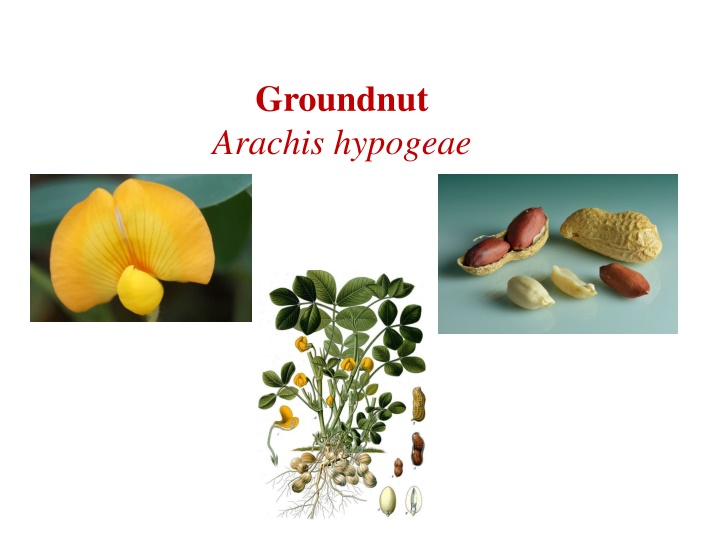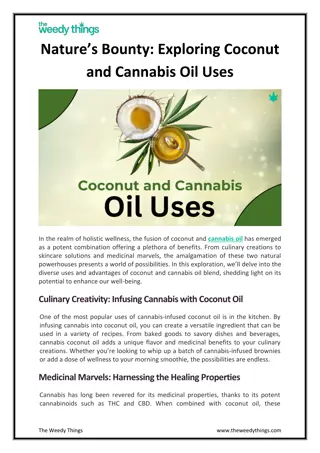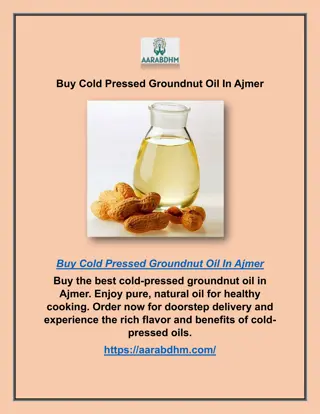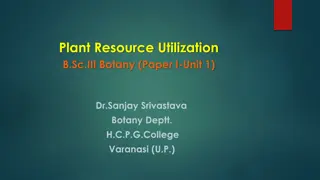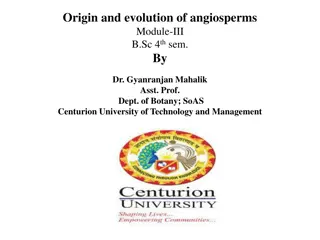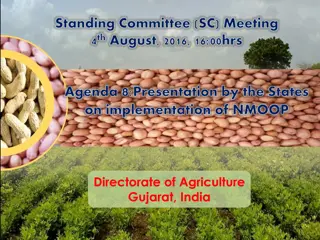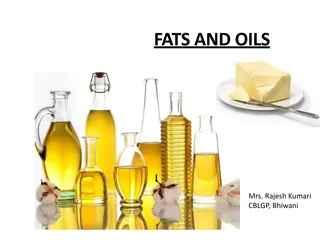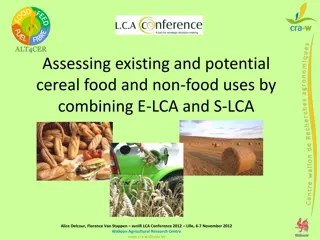All About Groundnut: Origin, Types, and Uses
Groundnut, also known as peanut, is a versatile crop with high oil and protein content, rich in vitamins and minerals. Originating in South America, it is popularly grown worldwide with different cultivation practices. Learn about the various types, classification, uses, and cultivation areas of this important legume.
Download Presentation

Please find below an Image/Link to download the presentation.
The content on the website is provided AS IS for your information and personal use only. It may not be sold, licensed, or shared on other websites without obtaining consent from the author.If you encounter any issues during the download, it is possible that the publisher has removed the file from their server.
You are allowed to download the files provided on this website for personal or commercial use, subject to the condition that they are used lawfully. All files are the property of their respective owners.
The content on the website is provided AS IS for your information and personal use only. It may not be sold, licensed, or shared on other websites without obtaining consent from the author.
E N D
Presentation Transcript
Groundnut Arachis hypogeae
Arachis hypogea derived from the Greek words Arachis meaning legume and hypogea meaning below the ground. Synonyms of Groundnut Peanut, eathnut, monkeynut, goober, moongfal and Manila nut. Importance of Groundnut: High oil content (45%) High protein content (26%) Rich in Vitamin Rich in Minerals like iron, calcium and phosphorus
Uses of Groundnut Kernel is used for various culinary preparations Source of edible oil Shell is used as fuel Cake is used as a nutritional and palatable cattle feed Cake is used as soil amendment It is a popular sequential crop/ intercrop with other cereals/oilseeds due to its N fixing ability. Dry haulm is also very popular palatable cattle feed
Classification Based on branching and growing habits : Erect type or bunch type: Includes the varieties of Sub species fastigiata and vulgaris. Includes Groups called Valencia and Spanish Spreading or trailing type: Includes the varieties of Sub species procumbens (Virginea type) Includes Groups called hypogea and hirsuta Semierect type: Includes the varieties of Virginea, which may be spreading or bunch The nature of branching, flowering, and growth habit and pod formation differ vastly in these groups. As a result, the yield potentiality of varieties belonging to such groups also differ. Most of popular and released varieties belong to A. hypogea group
Bunch type Small- medium seed Non dormant Height upto 60 cm Matures in 105-120 days Pale green leaves Rounded leaflets Spreading type Medium-large seed Moderately dormant Height upto 30 cm Matures in 130-175 days Dark green leaves Pointed leaflets
Origin and History Originated in Brazil of South America, and was introduced in Africa and North America. It was introduced in India by the Europeans in Sixteenth century. It is now popularly grown in almost all the tropical and subtropical countries.
Area and distribution Grown in 24 million hectare with 40 million tons as pods globally. It is cultivated in India (5.5 million ha), China (4.8 milllion ha), Nigeria (2.5 million ha) and Nigeria, Sudan and USA. In USA, its productivity is as high as 4.34 t/ha, while in India it is lowest (1 t/ha). In India, it is mainly distributed in the states of Andhra Pradesh, Karnataka, Tamil Nadu, Gujarat, MP and Rajasthan.
Soil requirement Sandy, sandy loam or clay loam, well drained soils with high organic carbon status are desirable. It can tolerate pH up to 5.0
Climatic Requirement For vegetative growth 21-28oC; for reproductive growth 24-30oC and for pod growth 28-33oC is required. Temperature lesser than 18oC reduce the growth rates. Temperatures upto 45oC can be tolerated. Low light intensity is not desirable for pegging and flowering stages; requires annual rainfall of 500-1200 mm, but continuous rainfall during vegetative growth increases the height of bunch types and reduces the pod yield. In general, rains at harvesting are undesirable, but may help harvesting in crusting soils.
Botanical description of plant Groundnut in general is short stature plant grows to a height of 15-40 cm. Main axis consists of primary branches (n+1), secondary branches (n+2) and tertiary branches are usually found in spreading type giving them prospate appearance. Leaves are alternate, stipulate and quadrifoliate. Flowers are orange yellow color, typically papilaceous flowers. Flowers are borne on axils of leaves, flowers are bisexual, zygomorphic, complete and sessile (with out pedicel). Crop is predominantly a self pollinated because of cleistogamy. Pollination takes place morning. As soon as fertilization is complete flowers are fertilized.
After fertilization, intercalary meristem becomes active at the base of ovary and above the point of attachment called as hypantheum producing new tissues below ovary and results in elongated stalk called Peg . Because of geotrophic nature, it enters soil, and bends in horizontal direction and at the end of pegs, pods are borne. Generally two occasionally 1, 3 or 4 fertilized ovules are borned at the tip of the peg, which later on swells to become pods. At maturity, kernels contain seeds with in the pods and testa is pink in colour but varies with red, violet and blotched testa with various color are also available.
Varieties Spanish (Bunch Pod yield Shelling % Oil% Region suitable type) JL-24 CO-1 (kg/ha) 1800 kg 1300 (RF) 75 74 50 50 Largely grown in Karnataka High HI and good for rabi in TN 2200 (Irrigate) 1200 (RF) KRG-1 73 49 Karnataka (Summer) 2200 (Irri) 1650 (RF) 3200 (Irri) 1200 (RF) 2000 kgs 1590 (RF) 2500 1500 3000-4000 CO-2 DH-8 TG-3 ICGS-11 VRI-1 ICGS-44 VRL-2 ICGS-37 77 72 - 70 74 70 48 48 51 46 47 48 48 49 48 48 Rose testa (TN) Karnataka, tolerant to CLS Kar, TN, AP (Summer) AP and Kar (Summer) TN/Kar AP and Kar TN and Kar (Bold seeded) Moderately tolerant to CLS, BND and drought
Valencia type (Bunch Pod yield Shelling % Oil% Region suitable type) (kg/ha) TMV-10 1700 kg 78 54 Varigatedly high oil content. TN and Kar. Bold seeded Kadiri-2 1800 kg 78 42 Kadiri-3 DRG-12 2100 kg 2600 kg 75 69 49 47 Tolerant to BND/ Tolerant to drought Virginia (Spreading type) S-230 GG-11 1280 kg 2300 kg 70 67 50 49
Intercropping Systems State Karnataka Area Dharwad System GN+Horse gram (3:1) GN+Chilli/Cotton (3:1) Bangalore GN+Red gram (6:1) Bijapur GN+Red gram (4:1) GN+Sunflower (4:2) AP GN+PP (4:1) GN+Pearl millet (3:1) GN+Castor (6:1) TN GN+Sunflower (3:1) GN+Pearl millet (6:1) GN+Castor (7:1) GN+Sesamum (4:1) GN+ Cotton (6:1) Gujarath GN+Sunflower/Pearl millet/Sesamum (1:1) GN+Castor 3:1/5:1 GN+Pigeonpea 5:1/8:1
Season Mainly kharif crop (June or 1st week of July- Harvesting during September to october. In many command areas, it is also grown as rabi/summer crop under irrigation. The crop requires around 120-130 days to mature.
Seed Rate The seeds (kernels) should be freshly decorticated at the time of sowing, although, seed pods can be stored for one year. Bunch type: Inter row spacing- 30-40 cm (100 kg kernels/ha appox 130 kg pods @ 75% shelling ) Spreading type: Inter row spacing- 45-60 cm (70-80 kg kernels/ha appox 105 kg pods @ 75% shelling ) Sowing is invariably carried ou using seed drill or mechanical planter
Nutrient management Nitrogen: Groundnut being a leguminous crop it is able to fix N with help of rhizobium. But it needs basal dose of 15-25 kg N/ha for realising good yields. In MH rhizobium treatment is done, 25 kg N is sufficient. In AP, in lighter soil 40 kg N + Rhizobium is applied. In Karnataka soil application of N + 2% urea spray + 0.5% FeSO4 at 30 and 70 DAS found beneficial.
Phosphorous: A dose of 40-50 kg P2O5 is recommended. Groundnut responds to P application if P levels in soil is less than 35 kg P2O5/ha. According to Ramareddy et al (1992) P is found to increase pod yield linearly up to 50 kg P2O5 kg/ha inn AP. In Gujrath according to Saguare et al. (1988) on clay soil, application of 50 kg P2O5 in combination with 25 kg S is known to increase pod yield, pod number and dry matter production and N content in nodules. P application in groundnut always leads to early flowering and early pegging. Among sources, best source of P is SSP, because in addition to 16% P2O5 it supplies 19.5% Ca and 12.5% S.
Potassium: Response to K application by the ground nut is seen if K2O level goes below 150 kg /ha. A dose of 20 kg K2O is recommended for rainfed soils and 40 kg K2O is recommended for irrigated conditions. Where as in sandy soils of Karnataka having pH of 5.8 with 0.58% organic carbon, 80 kg P2O5, 375 kg K2O/ha, 50:100:25 kg/ha for North Karnataka. In rainfed areas, all fertilizers are applied as basal dose but in irrigated condition N is applied in two split dose i.e. at planting time and at 30 DAS.
Secondary nutrition: Ca and S are known to absorb from fruiting zone by the pegs as well as developing pods. Best source of Ca and S is gypsum-29.5% Ca and 18.6% S. Threshold level of Ca should be 1 m. e. /100 g of soil in root zone and should be 3 meq in pod formation zone. Band placement of CaSO4 in pegging zone @ 500kg/ha at 30 DAS is known to increase number of developing pod by 18% and pod yield by 20 % besides improving shelling percentage and kernel weight.
Micronutrients: Deficiency of Zn in sandy soils and sandy loam soil and Fe in calcareous black soil of Gujarat, Karnataka and MH and boron deficiency in TN soil has been reported for several years. The uptake of Zn, Fe, Mn and Cu by groundnut crop yielding 1.9t/ha would be 208g, 4340 g and 176 g and 68 g/ha respectively. Therefore to overcome the Zn deficiency, 25-50 kg ZnSO4/ha at time of sowing depending on soil Zn level or 0.02% of foliar spray can also to be applied. When Zn is applied it increase nodules, chlorophyll content and increase pod yield. To over come Fe deficiency in calcareous soil, 25-30 kg as basal dose is known to improve pod yield by 15.6%. Boron threshold level in soil is 0.25%. If it is below apply 5-10% Borax/ha or 0.1% spray.
Weed management Reduction of 20-25% of yield has been recorded in groundnut due to weeds. To control weeds and also keep soil friable crop should receive one hand weeding + one or two hoeing, with bullock drawn implements. First hoeing is done after 3 weeks after sowing. Second hoeing at 15 days after first hoeing, third hoeing at 1 month after second hoeing. No intercultural operation should be done once peg penetration begins. Earthing up can be adopted only in case of bunch and semi spreading type of groundnut to facilitate maximum penetration of pegs and weeding can also be done quickly and effectively with help of hand hoe but this performs good only in case of light soils. It should be done before the weeds produce excessive growth.
Chemical weed control: Pre sowing application of Alachlor or Fluchloralin @1.5 kg a.i. /ha. Pre emergent application of Pendimethalin@1kg a.i./ha along with 2 inter cultural operations at 30 & 40 DAS is recommended for effective and economical weed control in groundnut.
Harvesting and Post harvest operations Harvesting is done by uprooting plants or harrowing and picking the pods. If the soil if fully dry at harvesting time and if the soil is hard, more pods remain inside. All the pods would come out with plant, if the soil moisture is ideal and the soil is sandy in nature. They are dried under sun to bring the karnel moisture to 9% and stored in gunny bags. Yield: 10-15 q /ha (Rainfed) 18-25 q /ha (Irrigated)
Pod filling A major issue deciding the yield The pod yield depends on Number of pods/plant Number of kernels/pod Filling is indicated by shelling % Shelling % = Kernel weight / Pod weight Kernel filling depends on calcium nutrition, soil moisture status at filling stage and soil temperature.
If appropriate post harvesting processing not adopted than there is a loss of yield. Appropriate post harvesting processing is necessary to prevent losses. High moisture content after harvesting leads to fast deteoration, increases free fatty acids, decolorisation of seeds. Foreign matter/non seed material causes quality impairments of seeds. High humidity and storage causes rapid damage to the kernels, fungal attack and development of toxins. Excessive heat in storage condition causes quality degradation, fire hazards, charring, burning, and degradation of seed quality, oil and protein denaturation.
Presence of damaged seeds will bring down the quality of oil. Excessive enzymatic activity in seeds results in low quality oil. Rodent attack during storage causes loss of seeds and contamination of seed with excreta. Improper and inadequate storage will cause fungal attack, mold growth and development of aflotoxins.
Drying and storage: It needs drying for storage and oil extraction. First drying is accomplished by delaying harvest of crop. Harvested crop is bundled and left in field for few days. Then they are transported to threshing yard and staked for further drying. When seed moisture reaches 20-25% the threshing is done and once pods are cleaned they are dried using mechanical driers to bring down moisture to 8-9%. Direct sundrying should be avoided as far as possible other wise it deteriorates oil quality. On an average groundnut stores well with less than 9% moisture and less than 65% RH and less than 300C. If seed moisture content is less than 7% can be stored for 2 months whereas pods with 7% moisture can be stored for 1 year. In rural areas, bags are used for storage which leads to quality deterioration of pods. Metallic or local mud bins are better for storage.
Thorough drying of the produce can be judged by three important indicators. The pods should give rattling sound when shaken. When kernels are pressed between thumb and index finger, it should split in to two cotyledons. When surface of kernel is rub hard then portion of testa should peal off. The best method of storing is in polythene bag gunny bag along with CaCl2 @ 250g/30 kg pods.
Pests and diseases Seed/ pre-emergence rot Tikka Rust Aphids White grub Bihar hairy caterpillar
Anti- Nutritional factors Groundnut is likely to contain mycotoxin (toxin metabolites of fungi) called aflotoxins. Many aflotoxins are produced by Aspergillus flavus and A. parasiticus. They are able to grow profusely during storage of pods/kernels even with low moisture, favored by high temperature and high humidity. These toxic substances can be carcinogenic and cause extensive poisoning, when consumed in large quantity. When pods are stored with kernel moisture higher than 9%, aflotoxins are likely to be generated.
To control aflotoxin : Exposure of kernels to 1 hr of light reduces the aflotoxins significantly. Avoid harvesting during rains Good drying Treatment with ammonia gas
